Introduction
The hand is a prehensile organ, it is endowed with grasping and precision movements for skilled work and it acts as a chief tactile apparatus. This is contributed by a higher degree of neuromuscular co-ordination and a larger cortical representation of the hand in the sensory and motor cortices of the brain. Hence, philosophically it may be said that the actions of the lumbricals of the hand are the indices of civilization of a race (Standring, 2005).
Evolution of grasping ability of the human being contributed by lumbricals may be attributed to the ecological context of such skills in the frogs (Adriana et al., 2008). Hence, human hand is a revolution in evolution. Indeed the lumbricals of the hand by producing flexion at the metacarpophalangeal joints and extension at the inter-phalangeal joints helps in various object manipulating skills like writing, stitching and any other forms of precision work. Lumbricals play a vital role in precision movements of the hand. These are four small muscles of the hand. They are numbered from lateral to medial side. They originate in the palm from the tendons of flexor digitorum profundus, pass distally along the corresponding metacarpophalangeal joint in front of the deep transverse metacarpal ligament. Each muscle forms a narrow tendon and on reaching the dorsal surface of the proximal phalanx joins the margin of the dorsal digital expansion (Soubhagya et al., 2008).
The lumbrical muscles, especially the 1st and 2nd lumbricals, are used as muscle flaps for the coverage of the median nerve and its palmar branches. Hypertrophy of the lumbrical muscles causes compression of the radial and ulnar collateral arteries, leading to chronic sub-ischemia (Mehta and Gardner, 1961). Hence presence work is undertaken to know the morphological variations in the lumbricals.
Materials and Methods
This study was conducted in the Department of Anatomy, Kasturba Medical College, Manipal with 30 cadavers of both sexes with the age range approximately between 35-65 years. The study was carried out during the routine dissection procedure for undergraduate medical students in the department of anatomy. A longitudinal incision was made from the distal end of the flexor retinaculum, up to the level of the metacarpophalangeal joint of the middle finger. The superficial fascia, the deep fascia and the flexor retinaculum were dissected and reflected. Then the tendons of flexor digitorum superficialis, flexor digitorum profundus, branches of median nerve and superficial palmar arch were retracted. The lumbrical muscles were carefully observed and isolated. They were then followed to their tendons which pass to the lateral side of the base of each finger and later, the tendons of each of the lumbrical muscles were traced up to their insertions. The study was carried out to check for the variations in the origin, insertion, innervations and the extension of lumbrical muscle.
Result
The detailed profile of patterns of variations in the lumbricals of the hand is shown in Table 1
Table 1- Showing the Profiles of Different Variations of Lumbricals of the Hand
. 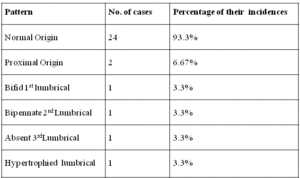
From the data of our present study, lumbricals with their normal attachments were observed in majority (93.3%) of palms. However, significant variations were also observed in some of the palms such as its proximal origin beneath the flexor retinaculum in 6.67% cases (Fig 1).
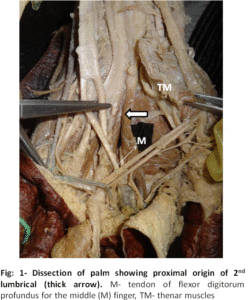
Fig: 1- Dissection of Palm Showing Proximal Origin of 2nd Lumbrical from the Tendon of Flexor Digitorum Profundus for the Middle Finger
Bifid 1st lumbrical were seen in 3.3% of cases (Fig 2) and equal percentage of cases showed the presence of bipennate 2nd lumbrical arising from lateral two tendons of flexor digitorum profundus muscle (Fig 3).
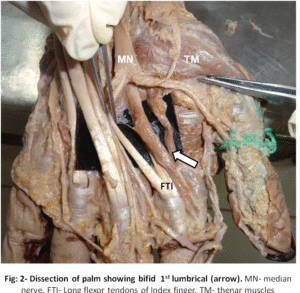
Fig: 2- Dissection of Palm Showing Bifid 1st Lumbrical

Fig: 3- Dissection of Palm Showing Bipennate 2nd Lumbrical
In all these cases, their patterns of insertion were normal. In 3.3 % of the cases, there was absences of 3rd lumbrical were noted (Fig 4).
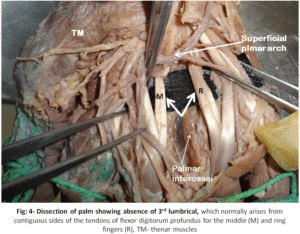
Fig: 4- Dissection of Palm Showing Absence of 3rd Lumbrical
With the similar frequency, the hypertrophied first lumbrical were observed with its normal attachments (Fig 5).

Fig: 5- Dissection of Palm Showing Hypertrophied First Lumbrical Originating from Tendon on Flexor Digitorum Profundus to Index Finger
In addition to these, rare variations like presence of additional muscle belly from the tendon of flexor pollicis longus were also observed (Fig 6).
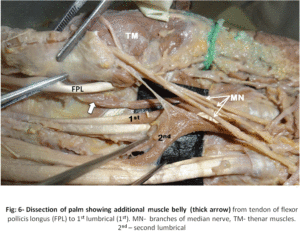
Fig: 6- Dissection of Palm Showing Additional Muscle Belly Arising from Tendon of Flexor Pollicis Longus (FPL) for First Lumbrical
The innervations pattern to each variant lumbricals were found to be normal that is first two being supplied by the median nerve and third and fourth being supplied by ulnar nerve. No additional or dual nerve supply has been observed in cases of bifid lumbricals.
Discussion
Lumbricals as a part of the intrinsic musculature is important for its digital movements. They are quite unique as they connect the flexors of the digits to the extensors. Variations in the attachments of the lumbricals are common. In a study which was conducted by Mehta and Gardner (1961), it was noted that the lumbricals had an occasional origin in the forearm or from a metacarpal or from the superficial instead of the deep flexor tendons and that the third and fourth lumbricals originated from a single tendon instead of two. The presence of an additional muscle belly for the first lumbrical was seen in present case which has a phylogenetical significance and the occurrence of such an anomalous muscle belly may compress the median nerve in carpal tunnel.
Anomalous and additional lumbrical muscle can cause carpal tunnel syndrome by compressing the median nerve (Chaudruc et al., 2000). Similar observation was seen in a study done by Singh et al., (2011) as a bipennate origin of first lumbrical, extending from the distal part of forearm and had split insertion.
A muscle which arose from the anomalous flexor pollicis longus tendon in the region of the metacarpophalangeal joint, passes across the narrowed first web space joined the lumbrical belly of the index and inserted into extensor hood of that digit. Because of its attachments and action, it was given the name musculus lumbricals pollicis. Additionally, notification of such muscular variants assumes importance in event of surgical intervention (Lister, 1991).
In the present study most of the lumbricals had a normal origin but some showed a proximal anomalous origin beneath the flexor retinaculum. Similar report has been reported by a study done by Siegel et al., (1995) with the incidence of 26.6% and opined that, it may cause compression of median nerve in carpal tunnel. It is also found that in case of carpal tunnel syndrome and in those in which repetitive hand motions were performed, the lumbricals had a significantly larger and proximal origin in the carpal tunnel which could be the cause of the carpal tunnel syndrome (Joshi et al., 2005).
Hypertrophy of the lumbrical muscles which could cause the compression of radial and ulnar arteries of the fingers likely to cause chronic sub ischemia (Singh et al., 1975).
The lumbricals also shows variations in being unipennate or bipennate. The present study showed the presence of bipennate 2nd lumbrical in 3.3% of the cases. The significance and etiology of such variant lumbrical was not found in literature. If the first lumbrical is bipennate instead of unipennate then two heads usually arise from the flexor digitorum profundus and flexor pollicis longus (Goldberg, 1970).
In the present study, one case showed rare anomaly of absence of third lumbrical. A study done by Braithwaite et al (1948), documented the absence of fourth lumbrical but with no clinical significance for this observation. A study by Kurzumi et al (2002) concluded that evidence of absence of 4thlumbrical was the most frequent absent of the lumbricals.
Conclusion
In the present study, though we observed presence of lumbricals with their normal attachment and morphology in majority of cases, a rare variations like their proximal origin, bi pinnate 2nd lumbricals, absence of 3rd lumbrical and hypertrophied lumbricals were also been encountered. These unusual variations assume wide range of clinical implications. Therefore, clinicians and hand surgeons should be aware of enormous variations in lumbricals during various surgical procedures of hand. Further, hypertrophied lumbricals can cause compression of the radial and ulnar digital arteries leading to chronic ischemia. Hence, a complete knowledge of possible variations of lumbricals is utmost essential.
References
Braithwaite, F., Channel, G. D., Moore, F. T. & Whillis. J. (1948). ‘The Applied Anatomy of the Lumbrical and Interosseous Muscles of the Hand,’ Guy’s Hosp. Reports, 97, 185—95.
Google Scholar
Chaudruc, J. M., Florenza, F., Riviere, C. & Arnaud, J. P. (2000). “White Finger and Hypertrophy of the Lumbrical Muscles,” Chir Main, 19 (4) 232-34.
Publisher – Google Scholar
Goldberg, S. (1970). “The Origin of the Lumbrical Muscles in the Hand of the South African Native,” The Hand, 2, 168-71.
Publisher – Google Scholar
Joshi, S. D., Joshi, S. S. & Athavale, S. A. (2005). “Lumbrical Muscles and Carpal Tunnel,” J Anat Soc India, 54(1) 12-15.
Publisher – Google Scholar
Kurzumi, M., Karwai, K., Honma, S. & Kodama, K. (2002). “Anomalous Lumbrical Muscles Arising from the Deep Surface of Flexor Digitorum Superficialis Muscles in Man,” Ann Anat, 184(4) 387-92.
Publisher – Google Scholar – British Library Direct
Lister, G. (1991). “Musculus Lumbricalis Pollicis,” J Hand Surg [Am], 16(4) 622-5.
Publisher – Google Scholar
Manzano, A. S., Abdala, V. & Herrel, A. (2008). “Morphology and Function of the Forelimb in Arboreal Frogs: Specializations for Grasping Ability?,” J.Anat, 213(3) 296-307.
Publisher – Google Scholar
Mehta, H. J. & Gardner, W. U. (1961). “A Study of Lumbrical Muscles in the Human Hand,” Am. J. Anat, 109, 227-238.
Publisher – Google Scholar
Siegel, D. B., Kuzma, G. & Eakins, D. (1995). “Anatomic Investigation of the Role of Lumbricals Muscle in Carpal Tunnel Syndrome,” J. Hand Surg (Am), 20(5) 860-3.
Publisher – Google Scholar – British Library Direct
Singh, G., Bay, B. H., Yip, G. W.. C. & Tay, S. (2001). “Lumbrical Muscle with an Additional Origin in the Forearm,” ANZ J Surg, 71, 301-2.
Publisher – Google Scholar – British Library Direct
Singh, J. D., Raju, P. B. & Singh Shamer. (1975). ‘Anomalous Insertion of Hand Lumbricals,’ J Anat Soc India, 24 (3) 122-5.
Soubhagya R Nayak, Ramya Rathan, Rachana Chauhan, Ashwin Krishnamurthy & Latha V Prabhu. (2008). “A Case Report -An Additional Belly of First Lumbrical Muscle,” Cases Journal, 1(1) 103.
Publisher – Google Scholar
Standring, S. (2005). Gray’s Anatomy, 39th Ed. Edinburgh: Elsevier Churchill Livingstone, 1021-3.
Publisher









